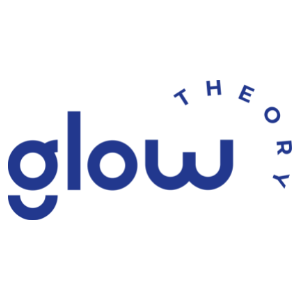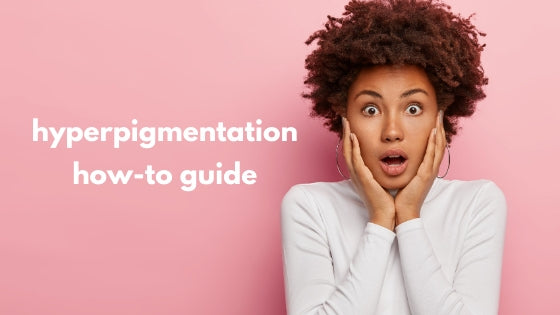One of the questions we're asked most often here at Glow Theory is how to get rid of hyperpigmentation or dark marks.
It's one of those skin issues that almost all of us struggle with in some way or at some point in our lives, and that's because there are so many different causes of hyperpigmentation. Whether it's caused by age, the sun, hormonal changes, or the leftover and unwanted result of a breakout, hyperpigmentation is the one skincare struggle we can all relate to.
Today we're going to look at what exactly hyperpigmentation is, factors that cause it or make it worse, as well as the best practices and ingredients for treating those dreaded dark marks.
What is hyperpigmentation?
There are a few different skin issues that are all conflated under the 'hyperpigmentation' umbrella, so what do we actually mean when we talk about hyperpigmentation? Post Inflammatory Hyperpigmentation (often referred to as 'PIH') is caused by the excess production of melanin, the pigment that gives skin its colour - when we tan, the resulting darker shade is a result of melanin in the skin. We often see this manifest in patches or specific dark spots on the face that can be difficult to get rid of.
Strictly speaking, Post Inflammatory Hyperpigmentation results after some kind of wound or inflammation in the skin, such as a break out, insect bite, or sunburn. Darker skin types (i.e., those with more melanin) are more prone to PIH, but it's something we all experience at some point in our lives since we all experience injuries to the skin or inflammation. The red marks that result after a breakout or wound to the skin (and often later develop into PIH) are known as Post Inflammatory Erythema or PIE, and can also be improved by many of the ingredients we talk about later in this blog post. Dealing with PIE early on will ensure it doesn't develop into PIH at a later stage.
Having said that, we also often see skin concerns such as age spots (also known as sun spots) and Melasma, referred to as hyperpigmentation. Age spots, which appear as we age and generally on more exposed areas of skin such as face, neck, chest, and hands, are a result of long term sun exposure. This can be worse for those of us living in the Southern Hemisphere, as we tend to be more exposed to the sun. Age spots are more common in those with lighter skin tones, though they affect everyone to a certain degree as they age.
Melasma is seen more often in women, and caused by hormonal changes such as pregnancy, or being on the contraceptive pill. We often see melasma develop on the forehead, high on the cheeks, the bridge of the nose and the upper lip area. As it is caused by the internal chemistry of our bodies rather than outside factors, it can also be the most difficult type of pigmentation to deal with and medical intervention in the form of laser treatments or prescription topicals are sometimes necessary.
What to do to get rid of hyperpigmentation
Consistency
Now that we know what causes the dark marks we all dislike, what can we do to lessen or, in an ideal world, entirely do away with them? The first thing we should note when it comes to dealing with hyperpigmentation, is that consistency is key. This is sadly the case with all things we want in life: nothing worthwhile is achieved quickly or easily. As with embarking on a healthier diet and fitness routine or working towards a goal or dream, you'll only see results if you are consistent with the actions you take. Some forms of pigmentation, such as age / sun spots, will come back fairly quickly once treatment stops or if you slack on prevention, so it's important to be proactive and maintain your routine once you've found one that works for you.
Sun Protection to prevent hyperpigmentation
We know the famous saying that prevention is better than cure, and this is especially true when it comes to sun exposure and hyperpigmentation, as the sun encourages melanin production in all skin types and skin tones. As we know, excess melanin production is responsible for pigmentation spots on our skin. Limiting exposure to the sun, especially to your face, is critical in both preventing and helping to heal pigmentation. Some of the products that help minimise pigmentation can also make your skin more sensitive to the sun, and sun exposure to skin that is currently suffering from a wound such as acne or inflammation will turn the resulting red PIE into PIH very quickly. To be clear: there is very little point in tackling your hyperpigmentation with the products and ingredients below, if you don't also use SPF every day, whether you're directly in the sun or not.
Our choices:
Axis-Y Complete Physical No Stress Sunscreen (ideal for oily, combo, acne-prone skin)
COSRX Aloe Soothing Sun Cream SPF 50 PA+++ (recommended for normal to dry and sensitive skin)
Klairs Soft Airy UV Essence SPF 50 PA++++ (works for most skin types, hydrating but not heavy)
Heimish Artless Glow Base SPF 50 PA+++ (great as a makeup primer, has a lovely dewy finish, works well for normal to dry skin)
Vitamin C to reverse sun damage
Vitamin C is probably the most well-known of the antioxidant ingredients in skincare, and can make a significant difference in reversing sun damage (such as age spots), while also protecting against further damage. Antioxidants are amazing at reducing the effects of inflammation-causing free radicals (and we know from earlier that inflammation can cause unwanted pigmentation) as well as stimulating the growth of collagen. Vitamin C is most effective in its Ascorbic Acid form. One important thing to note here is that Ascorbic Acid is famously sensitive to heat and light, so keep your serums in a cool, dark place - the fridge works great! Ascorbic Acid needs to be in a fairly low pH (acidic) formulation to be effective, so you may feel some tingling when applying a Vitamin C serum.
Our choices:
TIA'M My Signature C Source Vitamin C Serum (20% Ascorbic Acid; not for sensitive skin)
Alpha Hydroxy Acids to exfoliate those dark marks away
Alpha Hydroxy Acids (or AHAs) are a group of acids or chemical exfoliants that you'll find in serums but also commonly in toners and even sometimes moisturisers. The most common AHAs you'll see in skincare products are Glycolic Acid, Lactic Acid, Mandelic Acid and, the slightly less common, Citric Acid. AHAs work to increase the cell turnover rate and exfoliate the surface skin cells, as well as increasing blood flow to the skin, both of which help to lift stubborn pigmentation with consistent use. Due to this surface exfoliation, they'll help to brighten as well as minimise other signs of ageing such as fine lines. Just a note on AHA usage: don't overdo it; there is such a thing as too much of a good thing when it comes to chemical exfoliants - more gentle AHA toners can usually be used once a day, while serums and essences should be used 2 - 4 times per week depending on skin type. AHAs can also make your skin more sensitive to the sun, so load up on sunscreen when using them.
Our choices:
Jumiso Yes I Am Toner AHA 5% (mix of glycolic and lactic acid; can be used daily; works for all skin types)
COSRX AHA 7 Whitehead Power Liquid (7% glycolic acid; use 2 - 4 times a week depending on skin type)
Isntree Clear Skin 8% AHA Essence (glycolic and lactic acid; aimed at normal to dry skin; Use 2 - 4 times a week)
Vitamin A (Retinol) to stimulate production of new cells
The most effective forms of topically-applied retinol products such as Tretinoin are classified as a medicine and need to be prescribed by a doctor. However, you will also find retinol derivatives in many newer skincare products that are just as effective but a little more gentle than the prescription Vitamin A creams. Retinol stimulates production of new skin cells, and is effective in treating both acne and the signs of ageing, while also of course helping to rid us of hyperpigmentation. We don't currently stock a retinol-based product at Glow Theory, but watch this space!
Niacinamide, the multitasking marvel
Niacinamide (or Vitamin B3) is one of the most versatile skincare ingredients, effective for a variety of skin types and skin concerns, which is why it features in so many different product categories. As a melanin inhibitor, niacinamide works to minimise the overproduction of melanin after inflammation or exposure to sun. It's also amazing at restoring a damaged skin barrier (critical for healthy skin and therefore also for preventing and repairing dark marks) as well as minimising pores and preventing dull skin. Look out for formulations with 4% or more Niacinamide in them for efficacy against hyperpigmentation.
Our choices:
Axis-Y Dark Spot Correcting Glow Serum (5% niacinamide, includes rice extract for additional brightening; hydrating and glow-giving)
Jumiso All Day Vitamin Brightening and Balancing Serum (2% niacinamide, 86% vitamin tree extract, a natural antioxidant; great for most skin types)
TIA'M Vita B3 Source Serum (10% niacinamide and 2% arbutin; targeted for pigmentation)
Alpha Arbutin to inhibit melanin production
Also sometimes referred to as just Arbutin, this is derived from the bearberry plant and is the somewhat controversial hydroquinone's gentler, safer cousin. A melanin-inhibitor much like niacinamide, studies have shown significant improvement in dark spots from age as well as melasma when arbutin is used over a 3 month period.
Our choice:
TIA'M Vita B3 Source Serum (2% arbutin and 10% niacinamide; ideal for hyperpigmentation and suitable for most skin types)
Licorice extract - Korea's favourite brightening ingredient
A potent anti-inflammatory and antioxidant, licorice extract (often featured in ingredient lists under its scientific name Glycyrrhiza) is one of the safest and most gentle melanin inhibitors available, and studies have shown marked improvement in hyperpigmentation spots with continued use. Its antioxidant and anti-inflammatory powers also help to prevent any future hyperpigmentation once it has banished your existing dark marks.
Our choices:
Isntree Clear Skin PHA Sleeping Mask (fantastic multitasker as also contains 5% PHA, and 2% niacinamide - a brightening all-rounder!)
Heimish Bulgarian Rose Water Hydrogel Eye patch (combination of licorice extract and niacinamide, great for plumping and brightening undereyes)
TIA'M Vita B3 Source Serum (its third feature on this list, this serum ticks all the brightening boxes with it's cocktail of niacinamide, arbutin, and licorice extract)



6 comments
This was extremely helpful!
Must one use all that has been mentioned below or I can choose one that I prefer
Excellent post- love how you break everything down & make it all so much easier to understand! I know what to add to my routine now. Thank you 🙏🏻
Love this article. Really struggling with this problem after a particularly bad breakout. Very Helpful!
Awesome article, great advice and product recommendations.
Loved this thanks 😊 so informative and helpful with the product recommendations.
Regards
Priar
Leave a comment